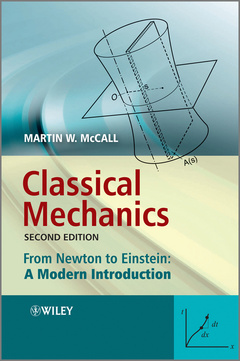Classical Mechanics (2nd Ed.) From Newton to Einstein: A Modern Introduction
Auteur : McCall Martin W.

The text starts with a careful look at Newton's Laws, before applying them in one dimension to oscillations and collisions. More advanced applications - including gravitational orbits and rigid body dynamics - are discussed after the limitations of Newton's inertial frames have been highlighted through an exposition of Einstein's Special Relativity. Examples given throughout are often unusual for an elementary text, but are made accessible to the reader through discussion and diagrams.
Updates and additions for this new edition include:
- New vector notation in Chapter 1
- An enhanced discussion of equilibria in Chapter 2
- A new section on a body falling a large distance towards a gravitational source in Chapter 2
- New sections in Chapter 8 on general rotation about a fixed principal axes, simple examples of principal axes and principal moments of inertia and kinetic energy of a body rotating about a fixed axis
- New sections in chapter 9: Foucault pendulum and free rotation of a rigid body; the latter including the famous tennis racquet theorem
- Enhanced chapter summaries at the end of each chapter
- Novel problems with numerical answers
A solutions manual is available at: www.wiley.com/go/mccall
Preface to Second Edition xi
Preface to First Edition xiii
1 Newton’s Laws 1
1.1 What is Mechanics? 1
1.2 Mechanics as a Scientific Theory 1
1.3 Newtonian vs. Einsteinian Mechanics 2
1.4 Newton’s Laws 3
1.5 A Deeper Look at Newton’s Laws 5
1.6 Inertial Frames 7
1.7 Newton’s Laws in Noninertial Frames 10
1.8 Switching Off Gravity 11
1.9 Finale – Laws, Postulates or Definitions? 12
1.10 Summary 12
1.11 Problems 13
2 One-dimensional Motion 15
2.1 Rationale for One-dimensional Analysis 15
2.2 The Concept of a Particle 16
2.3 Motion with a Constant Force 17
2.4 Work and Energy 17
2.5 Impulse and Power 19
2.6 Motion with a Position-dependent Force 19
2.7 The Nature of Energy 21
2.8 Potential Functions 22
2.9 Equilibria 25
2.10 Motion Close to a Stable Equilibrium 25
2.11 The Stability of the Universe 26
2.12 Trajectory of a Body Falling a Large Distance Under Gravity 30
2.13 Motion with a Velocity-dependent Force 32
2.14 Summary 34
2.15 Problems 35
3 Oscillatory Motion 39
3.1 Introduction 39
3.2 Prototype Harmonic Oscillator 39
3.3 Differential Equations 40
3.4 General Solution for Simple Harmonic Motion 41
3.5 Energy in Simple Harmonic Motion 43
3.6 Damped Oscillations 44
3.7 Light Damping – the Q Factor 47
3.8 Heavy Damping and Critical Damping 49
3.9 Forced Oscillations 51
3.10 Complex Number Method 57
3.11 Electrical Analogue 60
3.12 Power in Forced Oscillations 61
3.13 Coupled Oscillations 62
3.14 Summary 67
3.15 Problems 69
4 Two-body Dynamics 75
4.1 Rationale 75
4.2 Centre of Mass 75
4.3 Internal Motion: Reduced Mass 76
4.4 Collisions 77
4.5 Elastic Collisions 78
4.6 Inelastic Collisions 81
4.7 Centre-of-mass Frame 83
4.8 Rocket Motion 88
4.9 Launch Vehicles 90
4.10 Summary 92
4.11 Problems 93
5 Relativity 1: Space and Time 97
5.1 Why Relativity? 97
5.2 Galilean Relativity 98
5.3 The Fundamental Postulates of Relativity 99
5.4 Inertial Observers in Relativity 102
5.5 Comparing Transverse Distances Between Frames 103
5.6 Lessons from a Light Clock: Time Dilation 105
5.7 Proper Time 107
5.8 Interval Invariance 108
5.9 The Relativity of Simultaneity 109
5.10 The Relativity of Length: Length Contraction 110
5.11 The Lorentz Transformations 111
5.12 Velocity Addition 115
5.13 Particles Moving Faster than Light: Tachyons 116
5.14 Summary 118
5.15 Problems 119
6 Relativity 2: Energy and Momentum 123
6.1 Energy and Momentum 123
6.2 The Meaning of Rest Energy 129
6.3 Relativistic Collisions and Decays 130
6.4 Photons 131
6.5 Units in High-energy Physics 133
6.6 Energy/Momentum Transformations Between Frames 134
6.7 Relativistic Doppler Effect 136
6.8 Summary 137
6.9 Problems 139
7 Gravitational Orbits 143
7.1 Introduction 143
7.2 Work in Three Dimensions 143
7.3 Torque and Angular Momentum 144
7.4 Central Forces 147
7.5 Gravitational Orbits 151
7.6 Kepler’s Laws 157
7.7 Comments 159
7.8 Summary 160
7.9 Problems 160
8 Rigid Body Dynamics 165
8.1 Introduction 165
8.2 Torque and Angular Momentum for Systems of Particles 166
8.3 Centre of Mass of Systems of Particles and Rigid Bodies 167
8.4 Angular Momentum of Rigid Bodies 169
8.5 Kinetic Energy of Rigid Bodies 174
8.6 Bats, Cats, Pendula and Gyroscopes 175
8.7 General Rotation About a Fixed Axis 181
8.8 Principal Axes 186
8.9 Examples of Principal Axes and Principal Moments of Inertia 187
8.10 Kinetic Energy of a Body Rotating About a Fixed Axis 191
8.11 Summary 192
8.12 Problems 193
9 Rotating Frames 199
9.1 Introduction 199
9.2 Experiments on Roundabouts 200
9.3 General Prescription for Rotating Frames 202
9.4 The Centrifugal Term 204
9.5 The Coriolis Term 205
9.6 The Foucault Pendulum 207
9.7 Free Rotation of a Rigid Body – Tennis Rackets and Matchboxes 211
9.8 Final Thoughts 213
9.9 Summary 214
9.10 Problems 214
Appendix 1: Vectors, Matrices and Eigenvalues 217
A.1 The Scalar (Dot) Product 217
A.2 The Vector (Cross) Product 218
A.3 The Vector Triple Product 219
A.4 Multiplying a Vector by a Matrix 220
A.5 Calculating the Determinant of a 3 × 3 Matrix 220
A.6 Eigenvectors and Eigenvalues 221
A.7 Diagonalising Symmetric Matrices 223
Appendix 2: Answers to Problems 225
Appendix 3: Bibliography 229
Index 230
Date de parution : 10-2010
Ouvrage de 256 p.
17.3x25.2 cm
Date de parution : 10-2010
Ouvrage de 256 p.
16.9x24.4 cm



